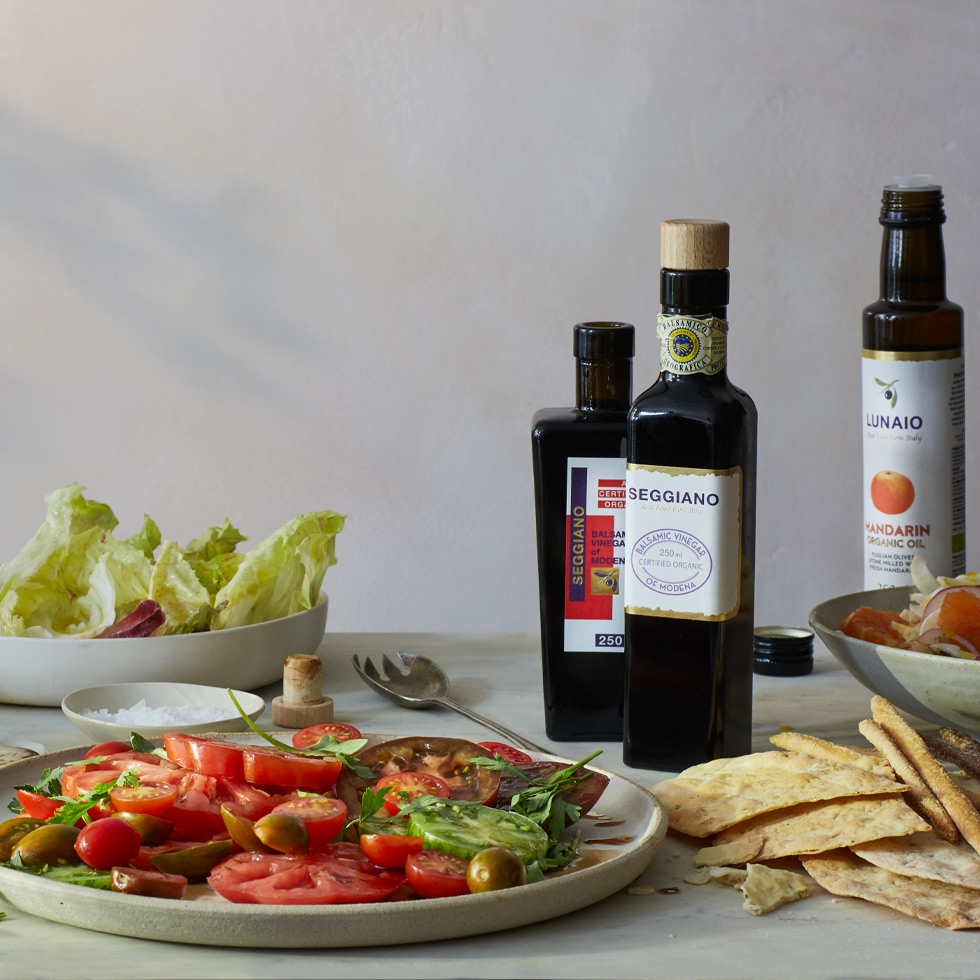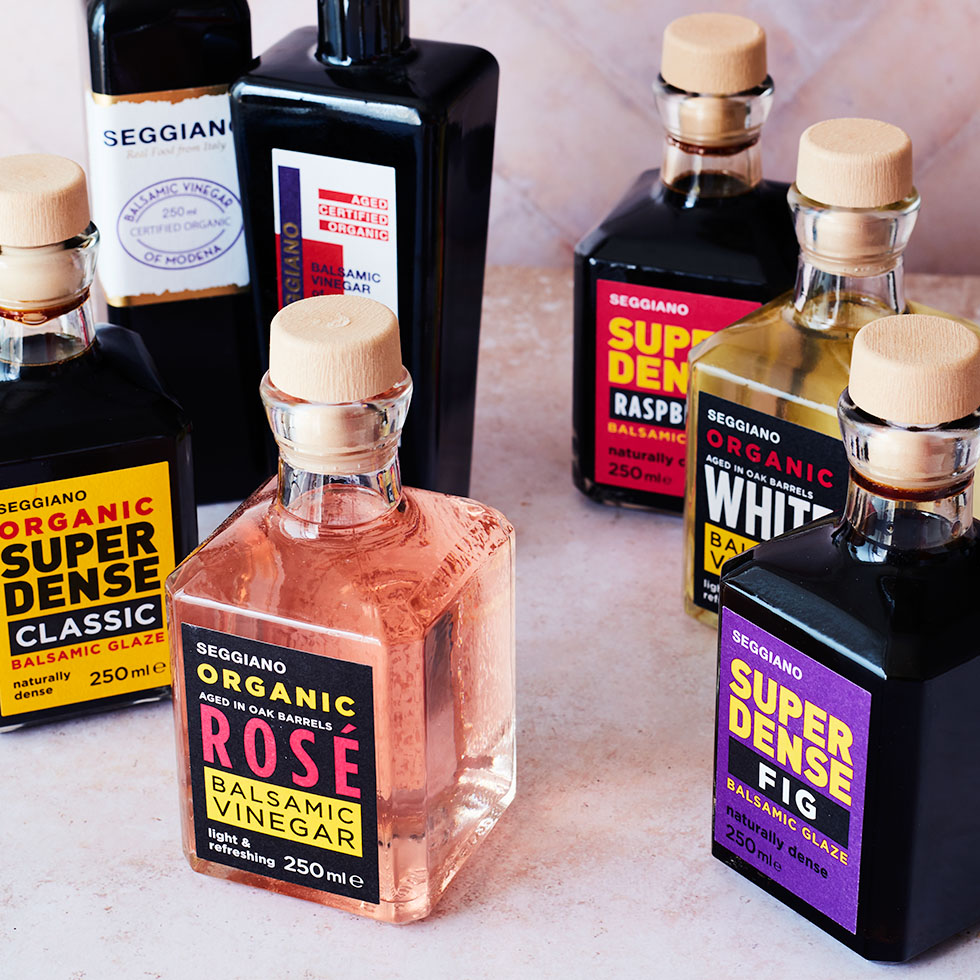0
No products in the basket.
FREE UK DELIVERY when you spend over £40

Share via
The first written record of balsamic relates that Holy Roman Emperor Henry III was gifted a small vial of it while travelling through Emilia Romana in 1046 AD. Still, balsamic wouldn’t start to gain any real global popularity until well into the 20th century. Now a coveted delicacy among salad lovers everywhere, its ubiquity is surely testament to its appealing umami flavours. From the sachets of dubious brown liquid labelled ‘balsamic vinaigrette‘ accompanying limp motorway gas station salads the world over to the platters of the loftiest triple Michelin star restaurants of our bustling mega-metropolises, balsamic is very much on the menu and here to stay.
The above-mentioned culture of innovation and experimentation in Italian food and farming isn’t some lost relic of times past; it’s a living, breathing and changing tradition, as alive today as ever. In fact, with the ever-growing global interest and demand for good quality Italian fare, alongside advances in production technology/technique and the veritable avalanche of snowballing scientific research into nutrition and human health, the culture could be said to be enjoying a renaissance!
Often when we visit our artisan producers they’re excited to share with us some new innovation or other – a novel eco/vegan-friendly way of filtering grape must for balsamic production; a nifty trick to reduce a glaze without the use of any nasty thickeners, sweeteners or E-numbers like caramel (which our entire range is free from); a natural way to stabilise a white balsamic without adding sulphites – even this millennia-old tradition is still evolving.
Besides being a delicious and versatile condiment for any kitchen and level of cheffing, a premium balsamic provides a whole host of health benefits, strengthening bones through improved mineral absorption and balancing blood sugars. Balsamic vinegar also contains antioxidants like the bioflavinoid quercetin, which help fight against cell damage and repair free radicals.
Nowadays, many different types of balsamic vinegar are on the market, from refreshing White and Rosé

This is our premium everyday balsamic, made entirely through natural, vegan methods from the sole ingredient of organic grape must. It spends less time reducing in hardwood barrels, so it’s thinner and less sweet than our Organic Aged or range of glazes and accordingly has different strengths in the kitchen. Matured is our go-to choice for value and versatility – you can do so much with one product!
We love using it when marinading roasted seasonal vegetables for the rich, caramelised flavours it lends. It’s excellent with grilled or roasted meats, too, though be sure to turn the meat regularly, so the balsamic doesn’t burn. In frying, balsamic tends to quickly sear the exterior of the protein and make the pan stick, so grilling or roasting is preferred! For seafood, the acidity of vinegar can ‘cook’ the fish if left to marinade too long, so it’s best to brush a little on top just before and during cooking.
Almost any dish that uses wine, in particular red, can substitute or supplement said vino with a healthy splash of Matured Balsamic – luxury gravy anyone? French cuisine can be fused with a sweet Italian twist by using balsamic at the same stage in the recipe that one would add wine. As balsamic is thicker, denser and sweeter than wine, less is needed for the same effect. The same goes for our light White or Rosé Balsamic, for any recipes that call for white wine. Instead of completely swapping out wine for balsamic, we tend to supplement, adding a generous splash of balsamic and a little less wine than usual.
A dash will liven up soups, its qualities marrying particularly well with earthy flavours like lentil, barley, pumpkin and squash and of course, it works wonders in salad dressings. Its balanced tart acidity and soft sweet tones best pair with light, summer salads, while our thicker, sweeter Organic IGP Aged is ideal for bitter leaf salads and stronger tasting raw veggies like radishes and beets.

Using the same natural methods and organic ingredients as our Matured variety, Seggiano Aged Balsamic is left to reduce in hardwood barrels for a minimum of 3 years, resulting in a fantastically sweet, thick balsamic. If you’re already familiar with our Matured and Super Dense offerings, you can think of it as somewhere in between, both in taste and viscosity. It pairs beautifully with fatty meats, roasts and stews, enriching dishes both during cooking and as a garnish before serving. A favourite of ours is using it to glaze roasted mushrooms – the acidity and rich umami taste profile marry excellently with funghi, from button to shiitake and all in between! Drizzle some over your ‘shrooms just after they’ve come out of the oven.
It makes for a tasty alternative to cream cheese when drizzled over toasted bread and generally goes really well with salty Mediterranean flavours – think capers, garlic, thyme, sage, rosemary, olives, smoked fish and so on.
You can also reduce our Aged in a pan to create a glaze – but be careful as it can turn from syrup to burnt caramel very quickly if you aren’t paying attention! This reduction, or glaze, can be used over your favourite veggies, meats, salads or soups or stored in a jar and kept in the pantry for later use.

Alongside the classic uses of glazes, like on veg and in meat marinades, they can also be used to enhance cheeseboards, sweet dishes and desserts. A few drops of our Organic Super Dense Glaze drizzled across your cheeseboard will send your tastebuds straight to heaven and beautify presentation to boot. Top candidates include soft, creamy goat or sheep’s cheese like a young pecorino, stronger-tasting cheeses like parmesan and even blue cheeses like gorgonzola. A simple salad of mozarella, basil and tomato (Insalata Caprese) is usually dressed with balsamic for the knock-out combo of mozzarella’s creaminess and the sweetness of balsamic.
The same goes for any creamy dessert – fresh strawberries and vanilla ice cream with a streaky balsamic glaze atop is to die for. Our naturally dense Fig Balsamic Vinegar Glaze, made in Modena with 24% fig extract, is perfect for such dishes – and for the adventurous among us – try adding a splash to your Bloody Mary sundowner for a sophisticated, rich twist.
Our Raspberry Super Dense Balsamic Glaze, made in Modena with 27% raspberry juice, is more vibrant and tart than its figgy sister and works best with raw veg or as a glaze on roasted meats, as well as to garnish desserts.
They say variety is the spice of life, and what better way to liven things up than with our Chilli Balsamic Glaze. Made in Modena with certified organic Lambrusco di Sorba grapes, this rich dark glaze unifies tart, sweet and spicy flavours. Use it to dress homemade french fries and grilled veg, marinade meats and enrich sauces.
White and Rosé Balsamic Vinegar are fairly new additions to our range, and we’re having lots of fun experimenting with their uses. Tart, crisp and refreshing in comparison to a dark balsamic, these two pair best with light flavours; summer salads, delicate sauces, recipes that use white wine or as a punchy garnish. We love to add a tablespoon or two to sauteing bitter greens, which softens and sweetens them nicely. Try adding a liberal splash next time you’re making mashed potatoes for a vibrant touch, and for those of us who care to imbibe, see our lovely gin cocktail recipe here for some hedonistic inspiration.
Our impassioned producers up in Modena have found a clever way of creating our premium White and Rosé balsamic without the use of any added sulphites. These nasty additives are commonly employed to stabilise the colour of a light balsamic and prevent them from browning over time. While naturally occurring sulphites are often antioxidant-rich, their lab-made synthetic counterparts aren’t something you want in your diet.
There we have it; the rich, delicious world of balsamic vinegar. We hope you’ve found this article informative and appetizing!
Share via
Balsamic Heaven
Explore the Seggiano Premium Balsamic Vinegar of Modena range